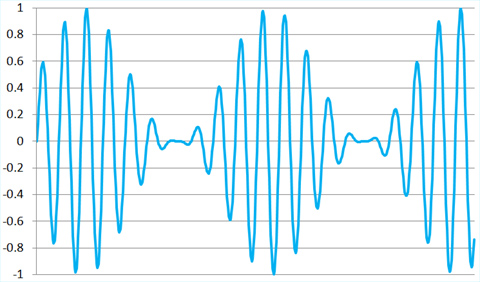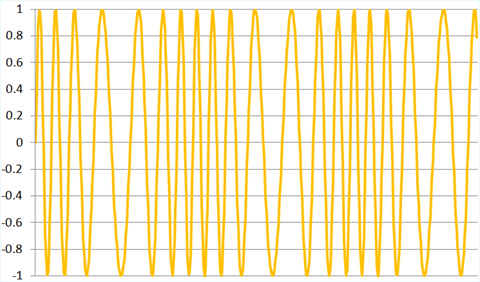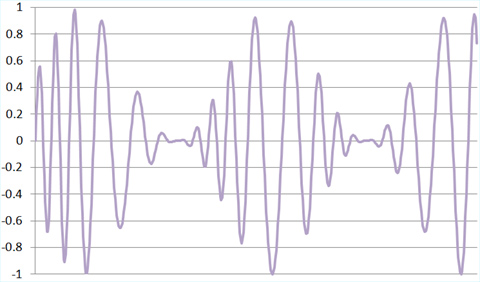Sunday 18 February, 2018, 11:10 - Broadcasting, Licensed
Back in December when we discussed the launch of Radio Caroline on 648 kHz and suggested that they were using wider bandwidth AM, Mike left a comment concerning Stereo AM. Stereo AM makes a great article for a post, so here we go!AM broadcasting in the medium-wave (MW) band is traditionally mono only. Back in the early 1980's four competing technologies were running trials of AM stereo, and in 1988 a solution proposed by Motorola called Compatible-Quadrature Amplitude Modulation (C-QUAM) which had gained significant popularity, was chosen as the de-facto standard in the USA (it was formally adopted in 1993). The word 'compatible' refers to the fact that one of the primary criteria for the solution was that an 'old fashioned' mono AM receiver would not notice any difference when tuned to an AM-stereo signal, that is to say that it would continue to receive a mono signal as if nothing had changed. Thus the stereo signal would remain compatible with mono receivers (note that exactly the same is true of FM stereo).
 The C-QUAM solution used the properties of AM and of FM to do something novel. In an AM waveform (as shown on the right), the information (in this case audio) is imposed onto the transmission frequency (the 'carrier wave') by changing the amount of power transmitted, that is to say, changing the amplitude of the transmission and hence amplitude modulation (AM). At the receiver, only the amplitude of the signal is used to recover the data.
The C-QUAM solution used the properties of AM and of FM to do something novel. In an AM waveform (as shown on the right), the information (in this case audio) is imposed onto the transmission frequency (the 'carrier wave') by changing the amount of power transmitted, that is to say, changing the amplitude of the transmission and hence amplitude modulation (AM). At the receiver, only the amplitude of the signal is used to recover the data. For an FM system, the amplitude or power of the transmitter remains the same and only the frequency is varied, hence frequency modulation (FM). In reality, the amplitude of the signal at the receiver will often vary, especially if the receiver is mobile, but as long as the signal that arrives at the receiver is strong enough to overcome any background noise, the receiver will still be able to detect what frequency was being transmitted and recover the original data or audio.
For an FM system, the amplitude or power of the transmitter remains the same and only the frequency is varied, hence frequency modulation (FM). In reality, the amplitude of the signal at the receiver will often vary, especially if the receiver is mobile, but as long as the signal that arrives at the receiver is strong enough to overcome any background noise, the receiver will still be able to detect what frequency was being transmitted and recover the original data or audio. What Motorola did was to use both FM and AM at the same time. It is not as easy to see what is going on in the C-QUAM waveform shown on the right, but the principle is fairly straightforward. If you feed this signal into an AM receiver, it will only detect the changes in amplitude and will ignore the changes in frequency completely. If you feed this signal into an FM receiver, the opposite happens and the AM part of the signal is ignored and only the information modulated on the FM part of the signal is decoded. Hence you can send two sets of information at the same time, one using AM and the other FM.
What Motorola did was to use both FM and AM at the same time. It is not as easy to see what is going on in the C-QUAM waveform shown on the right, but the principle is fairly straightforward. If you feed this signal into an AM receiver, it will only detect the changes in amplitude and will ignore the changes in frequency completely. If you feed this signal into an FM receiver, the opposite happens and the AM part of the signal is ignored and only the information modulated on the FM part of the signal is decoded. Hence you can send two sets of information at the same time, one using AM and the other FM.Compatibility is maintained by sending the Left and Right signals added together on the AM element of the transmission, and the 'stereo difference' (Left minus Right) on the FM part. Thus a mono AM receiver will see no change, but a stereo FM receiver will be able to add the mono and difference signals together to recover the original stereo signal. This is the same principle that applies for stereo FM broadcasting, though the method of transmitting the sum and difference signals are different.
The C-QUAM system is actually a little more complex than the description I have given above, for example, a pilot signal is added into the FM part of the signal to alert receivers that the transmission they are receiving is in C-QUAM, but the logic is in principle the same.
There are lots of videos of C-QUAM AM stereo on YouTube, but the one below is perhaps one of the best illustrations of what it sounds like on-air. It's actually fairly impressive.
So why is it that you've probably never heard of Stereo AM before? Here are some thoughts:
- Though a number of stations (particularly in the USA, Canada, Japan and Australia) did adopt the standard, there may have been insufficient stations on-air for consumers to properly experience the difference.
- The cost of receivers was always higher than mono ones as they were far more complex. This was exacerbated for a while as Motorola held the patents for the system and would have charged manufacturers a handsome fee to adopt it (they were forced to remove such payments in 1993 in the US when the FCC formally adopted the system).
- The quality of transmission of AM stereo, though better than AM mono, was not competitive with FM stereo which, by the time the C-QUAM standard had been adopted, were far more widespread than when the original AM stereo trials began.
- Maybe, and this is just supposition, the types of station on AM were in themselves less popular than the growing FM market, or possibly in some cases the programme material (e.g. talk) was not well suited to stereo.
